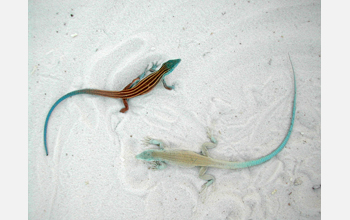Multimedia Gallery
Adaptation and speciation studies (Image 5)
Little striped whiptail lizards at White Sands, New Mexico. These lizards, as well as the lesser earless lizard and the Eastern fence lizard, have evolved blanched coloration at White Springs.
Scientists from the lab of Erica Bree Rosenblum, an assistant professor in the Department of Environmental Science Policy and Management at the University of California, Berkeley, have identified the specific mutations that turn White Sands' lizards white. They also have conducted experiments to see whether White Sands' lizards are becoming new species. For example, earless lizards will preferentially choose other White Sands' lizards as mates. Therefore, researchers can study both adaptation and speciation at White Sands.
The stark, white dunes of White Sands are an ideal environment to observe evolution in action. These dunes are geologically very young -- only a few thousand years old -- and in that time, a number of animals have adapted to this new environment. Natural selection has favored lighter colored animals on the dunes for camouflage against the white sand and avoidance of predators. Species of mammal, reptile and insect have rapidly developed adaptations to this unusual environment.
This research was supported by National Science Foundation grant DEB 03-09327. As of 2011, the research is now supported by an NSF CAREER (Faculty Early Career Advancement) program award. For more information about this research, see the NSF press release Looks Can Be Deceiving, or visit the Rosenblum lab website Here. (Date of Image: 2000-2009) [Image 5 of 11 related images. See Image 6.]
Credit: Erica Bree Rosenblum, University of Idaho
Images and other media in the National Science Foundation Multimedia Gallery are available for use in print and electronic material by NSF employees, members of the media, university staff, teachers and the general public. All media in the gallery are intended for personal, educational and nonprofit/non-commercial use only.
Images credited to the National Science Foundation, a federal agency, are in the public domain. The images were created by employees of the United States Government as part of their official duties or prepared by contractors as "works for hire" for NSF. You may freely use NSF-credited images and, at your discretion, credit NSF with a "Courtesy: National Science Foundation" notation.
Additional information about general usage can be found in Conditions.
Also Available:
Download the high-resolution JPG version of the image. (1 MB)
Use your mouse to right-click (Mac users may need to Ctrl-click) the link above and choose the option that will save the file or target to your computer.



